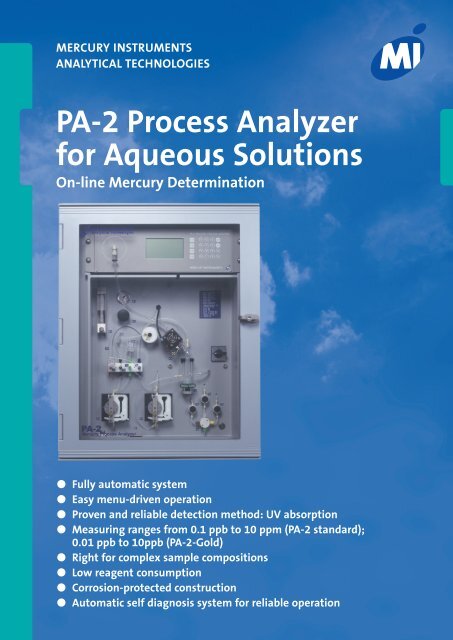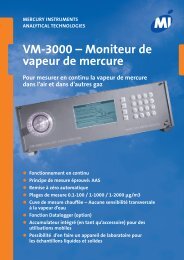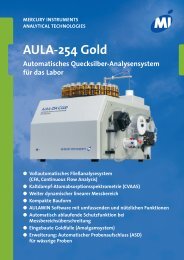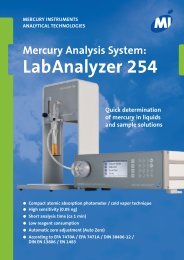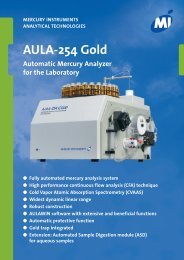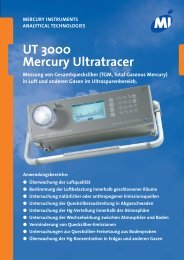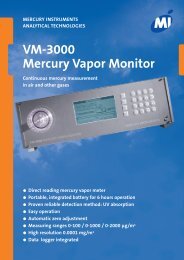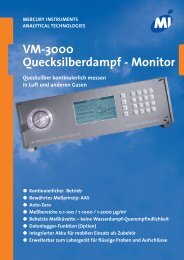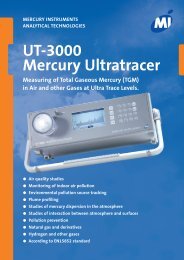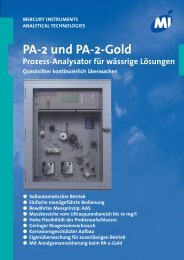PA-2 Process Analyzer for Aqueous Solutions - Mercury Instruments ...
PA-2 Process Analyzer for Aqueous Solutions - Mercury Instruments ...
PA-2 Process Analyzer for Aqueous Solutions - Mercury Instruments ...
You also want an ePaper? Increase the reach of your titles
YUMPU automatically turns print PDFs into web optimized ePapers that Google loves.
MERCURY INSTRUMENTS<br />
ANALYTICAL TECHNOLOGIES<br />
<strong>PA</strong>-2 <strong>Process</strong> <strong>Analyzer</strong><br />
<strong>for</strong> <strong>Aqueous</strong> <strong>Solutions</strong><br />
On-line <strong>Mercury</strong> Determination<br />
● Fully automatic system<br />
● Easy menu-driven operation<br />
● Proven and reliable detection method: UV absorption<br />
● Measuring ranges from 0.1 ppb to 10 ppm (<strong>PA</strong>-2 standard);<br />
0.01 ppb to 10ppb (<strong>PA</strong>-2-Gold)<br />
● Right <strong>for</strong> complex sample compositions<br />
● Low reagent consumption<br />
● Corrosion-protected construction<br />
● Automatic self diagnosis system <strong>for</strong> reliable operation
On-line <strong>Process</strong> Control of <strong>Mercury</strong> with the <strong>PA</strong>-2 / <strong>PA</strong>-2-GOLD<br />
The mercury process analyzer <strong>PA</strong>-2 is used <strong>for</strong> continuous monitoring of mercury concentrations in industrial<br />
processes and in the environment. Applications include effluent and quality control in chlorine-alkali plants,<br />
monitoring of scrubber water of waste incinerators and power plants, control of industrial sewage and purification<br />
plants, quality control of sulphuric acid and caustic solutions, drinking water, surface water etc.<br />
Flexibility in Sample Digestion<br />
In practice mercury analysis sample matrices very often show different and variable compositions. Depending<br />
on the chemical process the <strong>for</strong>ms of mercury differ: elementary, ionic, as an organic compound or as insoluble<br />
sulfide. The <strong>PA</strong>-2 offers a variety of sample pretreatment procedures to allow highly precise determination of<br />
total mercury in all these samples, with the results from the <strong>PA</strong>-2 showing very good correlations with standard<br />
laboratory analyses. High flexibility is achieved by the modular structure of the sample pretreatment. This<br />
allows the user to choose from the following digestion methods:<br />
● Sample digestion with hydrochloric acid + potassium permanganate<br />
● Sample digestion with sulphuric acid + potassium permanganate<br />
● Sample digestion with hydrochloric acid + sodiumchlorate<br />
● Sample digestion with Fenton’s reagent<br />
● Sample digestion with bromide/bromate<br />
The integrated heated reaction module allows accelerated sample digestion at higher temperatures.<br />
Proven Measurement Principle<br />
The detection of mercury contained in the sample occurs in an optical cell made of fused silica (Suprasil). In<br />
a first step mercury is reduced to the elementary state by means of tin(II)chloride or NaBH4. Subsequently<br />
mercury is stripped from the aqueous phase with an air stream and carried into the optical cell. Here the UV<br />
absorption measurement is conducted at a wavelength of 253,7 nm. This analytical technique called „cold<br />
vapor method“ shows extreme sensitivity and selectivity. It has been reliable and proven <strong>for</strong> many years. In<br />
contrast to the occasionally recommended atomic fluorescence method the analytical technique utilized by<br />
the <strong>PA</strong>-2 is extremely low in interference and does not require expensive noble gas as a carrier.<br />
Continuous and Interval Operation<br />
The <strong>PA</strong>-2 analyzer is controlled by a built-in computer and operates fully automatic. The continuous measuring<br />
mode can be switched over to a periodic measuring mode (<strong>for</strong> example 10 minutes of measurement every hour).<br />
Auto-Cal. Check: periodically the instrument switches from the sample stream to a calibration solution to check<br />
any deviation from the reference value. A status signal is generated if the value measured is out of range.<br />
Auto-Zero: the zero line of the analyzer is adjusted automatically after a preset period of time.<br />
Self-Cleaning: Precipitations like manganese dioxide are dissolved by an automatic rinse step which makes<br />
manual cleaning superfluous.<br />
Easy to Operate<br />
The <strong>PA</strong>-2 is operated via a waterproof mem brane keypad. All inputs required are selected in a readily understandable<br />
menu shown on the graphical display. It is also possible to ini tiate some functions like Auto Zero<br />
from an external computer via the RS 232 interface.
Display and Output of Measurements<br />
The analytical results are continuously displayed on an LCD in<br />
micrograms per litre and as absorption units. A linear electrical<br />
signal (4 ... 20 mA) is also output and can be connected to a<br />
recorder or to the analog input of a data aquisition system.<br />
Automatic Self Diagnosis System<br />
Displayed data during<br />
continuous measurement mode<br />
The <strong>PA</strong>-2 is equipped with sensors to detect malfunctions of the<br />
system and triggers an alarm <strong>for</strong> the operator. The following<br />
functions/malfunctions are checked and indicated:<br />
Reagent pump, Sample pump, Stripping air flow, Leakage of fluids, Photometer lamp, Calibration.<br />
These features permit reliable unattended operation. Malfunctions are reported to the user both optically and<br />
via a status signal.<br />
Minimum Maintenance Work and Maximum Service Life<br />
The <strong>PA</strong>-2 is not a laboratory analyzer simply converted <strong>for</strong> process applications but has especially been<br />
designed <strong>for</strong> operation under harsh industrial conditions. The number of parts subject to wear has been<br />
minimized and particularly durable components have been chosen <strong>for</strong> use in critical locations. This results<br />
in extended maintenance intervals. The stripping unit is based on an aerosol-free principle and the need <strong>for</strong><br />
cleaning the optical cell is particularly low.<br />
Industrial Grade Design<br />
To provide optimum protection against corrosive environments<br />
all parts of the <strong>PA</strong>-2 <strong>Mercury</strong> <strong>Analyzer</strong> are enclosed<br />
in an industrial-grade cabinet made of fibreglass-rein<strong>for</strong>ced<br />
polyester (protection class IP 66; NEMA 4X; etc.).<br />
The electronic circuitry is shielded from the wet chemical<br />
section by a chemically resistant wall.<br />
Communication with<br />
External Computers<br />
The following data is available at the<br />
serial RS 232 interface:<br />
● Actual mercury concentration<br />
● Status (Calibration - Zeroing -<br />
Maintenance - Malfunction)<br />
For use in harsh industrial environments:<br />
<strong>Mercury</strong> <strong>Process</strong> <strong>Analyzer</strong> <strong>PA</strong>-2<br />
Options<br />
● Dilution Unit: based <strong>for</strong> samples with high concentrations of salt or <strong>for</strong> caustic soda,<br />
dilution ratio up to 1:50, automatic online control<br />
● Multiplexer: <strong>for</strong> measuring alternatively two different sample points<br />
with different mercury concentrations<br />
● <strong>PA</strong>-2-Gold Module: <strong>for</strong> measuring of very low mercury concentrations by means of<br />
preconcentration at a GoldTrap (UT-3000)
<strong>PA</strong>-2 <strong>Mercury</strong> <strong>Process</strong> <strong>Analyzer</strong><br />
Technical Specifications<br />
Measuring principle: UV-Absorption<br />
Wavelength:<br />
254 nm<br />
UV source:<br />
Electrodeless low-pressure mercury lamp<br />
Stabilization method: Double beam (reference beam) method<br />
Optical cell:<br />
Fused silica (Suprasil)<br />
Optical cell heating: approx. 70°C<br />
Measuring range:<br />
continuously adjustable<br />
0.1...10 μg/l and 0.05...5 mg/l (standard);<br />
up to 100 mg/l (with dilution unit);<br />
0.01…10 µg/l (<strong>PA</strong>-2-Gold)<br />
Sensitivity:<br />
0,01 µg (<strong>for</strong> 0...1 µg measuring range)<br />
Response time (99% signal): approx. 1 minute<br />
Carrier gas:<br />
Air, approx. 30 l/h, 1–2 bar<br />
Pump <strong>for</strong> liquids:<br />
Multichannel peristaltic pump<br />
Reduction reagent: Tin-II-chloride or alternatively sodiumhydroborate<br />
Reagent consumption: approx. 3 l / week <strong>for</strong> each reagent<br />
Sample digestion:<br />
HCl, H2SO4, KMnO4, H2O2,<br />
Fenton‘s reagent, Na-chlorate<br />
(depending on sample composition)<br />
Liquid-gas separation: Aerosol-free principle<br />
Input device:<br />
Waterproof membrane keypad<br />
Display of readings: Graphical LC display with background illumination<br />
Output <strong>for</strong> concentration: 4...20 mA; RS 232 bidirectional<br />
Output <strong>for</strong> status:<br />
Operational - Service - Malfunction, according to<br />
NAMUR 64 recommendations<br />
Housing:<br />
Fibreglass-rein<strong>for</strong>ced polyester,<br />
<strong>for</strong> use in highly corrosive environment<br />
Dimensions:<br />
775 x 612 x 329 mm (WxHxD)<br />
Weight:<br />
approx. 50 kg<br />
Specifications subject to change!<br />
© 2014 <strong>Mercury</strong> <strong>Instruments</strong> · <strong>PA</strong>-2 03-2014<br />
<strong>Mercury</strong> <strong>Instruments</strong> GmbH<br />
Analytical Technologies<br />
Liebigstrasse 5<br />
85757 Karlsfeld (Germany)<br />
Tel.: +49 (0)8131 - 50 57 20<br />
Fax: +49 (0)8131 - 50 57 22<br />
mail@mercury-instruments.de<br />
www.mercury-instruments.de


